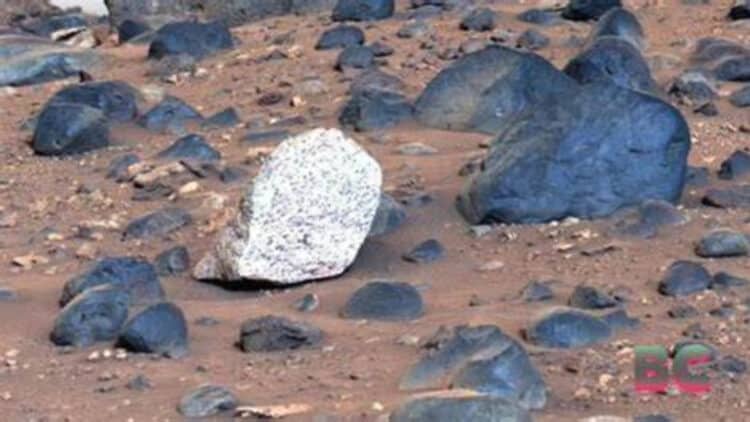Table of Contents Hide
Imagine a world where every rock you encounter might hold the secrets of an ancient riverbed or a volcano that last erupted millions of years ago. NASA’s Perseverance rover, which has been meandering through the Jezero Crater on Mars, recently unearthed something that’s sent scientists—and space enthusiasts—into a tizzy. Brace yourself for the unexpected: a “blue” rock formation, something that’s baffling geologists and giving every Mars aficionado reason to sit up.
The “Blue” Mystery on the Red Planet: What Did NASA Find?
Now, when you think of Mars, “red” is probably the first color that pops into your mind. It’s known as the Red Planet, after all! But this latest discovery seems to defy that title. Nestled in the Jezero Crater’s rugged terrain, Perseverance’s cameras spotted rocks with an unusual blue tint—a phenomenon that scientists just can’t explain yet. This isn’t some ordinary rock. It’s like finding a blueberry in a tomato field. Researchers aren’t sure whether it’s a quirk of mineral composition, unique to Mars, or something else entirely.
Speculations are running wild. Could it be minerals forged in Martian lava flows that somehow survived eons of erosion? Or is this a sign of ancient microbial life that may have influenced the rock’s chemistry? For now, it’s anyone’s guess. And you can bet the scientific community is thrilled by the possibilities.
Atoko Point: The Martian Grab Bag of Surprises
Our favorite Martian roving explorer didn’t stop there. Perseverance made its way to Atoko Point, a rocky hotspot that’s turning out to be a geological jackpot. Think of Atoko as the thrift store of Martian geology—it’s got a little bit of everything. Some rocks look like they’ve seen lava flows, while others appear to have been shaped by ancient rivers. Brad Garczynski, a researcher at Western Washington University, described these rocks as a “grab bag of geological gifts.” And he’s right! Every rock sample here is like a little postcard from Mars’ fiery and watery past, offering clues about its turbulent history.
Atoko Point’s rocks contain pyroxene and feldspar—minerals that hint at volcanic origins. These minerals are often found deep within planets, like hidden treasures that only emerge after millennia of shifting crust. Their presence on Mars opens a Pandora’s box of theories about the planet’s volcanic activity.
Why This Blue Rock Discovery Matters: The Water and Life Connection
Let’s get one thing straight: finding “blue” on Mars doesn’t just make for good headlines. This odd hue, coupled with minerals that suggest both volcanic and aquatic histories, might be our best clue yet that Mars was once, well, lively. Ancient water systems, hinted at by formations like Atoko Point and Mount Washburn, could have hosted microbial life billions of years ago. Picture it: a Mars with flowing rivers, possibly even lakes. This blue rock may be the missing piece in Mars’ evolutionary puzzle, hinting at an environment once conducive to life.
NASA’s SuperCam and Mastcam-Z have been hard at work capturing high-definition images and analyzing the rock’s composition. What makes this rock special isn’t just its color, but what it could tell us about Mars’ watery past. SuperCam detected mineral compositions similar to those formed in volcanic eruptions, and Mastcam-Z captured detailed visuals that showed traces of erosion likely caused by water flow. In other words, these rocks might be evidence of Mars’ ancient rivers carving pathways through lava-formed landscapes.
A Martian Waterway: Mount Washburn and the Evidence of Flowing Rivers
The discoveries around Mount Washburn—a highland area on Mars—are equally fascinating. This region holds a variety of rocks, from boulders to fine-grained sediments, each telling a story of how water might have flowed, surged, and shaped the Martian landscape. Geologists believe that Mars once had a system of rivers that brought in materials from other parts of the planet, much like rivers on Earth carrying rocks and sediments from afar. If you think about it, these rocks are more than just geological formations; they’re remnants of a Martian river network that could have supported life, even if only microbial.
NASA’s research suggests that this ancient river system didn’t just trickle but moved with force, carrying hefty boulders over impressive distances. This isn’t the story of a trickling stream—it’s evidence of a dynamic hydrological cycle on Mars, with the power to shape landscapes and perhaps nurture life.
The Quest for Answers: What’s Next for NASA’s Mars Missions?
As Perseverance continues its trek across the Martian terrain, each rock sample it gathers gets us closer to unlocking Mars’ secrets. Scientists are particularly keen to bring samples back to Earth, where advanced labs can dive even deeper into their composition. NASA and the European Space Agency are working on a sample return mission that could bring these mysterious blue rocks back by the early 2030s. Until then, every photo, every sample, and every surprising find is helping us connect the dots.
In the grand scheme of things, this “blue” rock might be just a pebble. But for those of us watching from Earth, it’s a milestone—a little beacon of mystery calling us to look closer, dig deeper, and ask if we’re really, truly alone in the universe.








